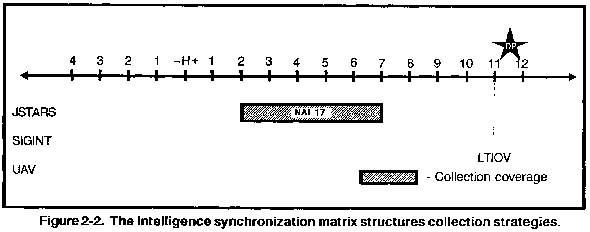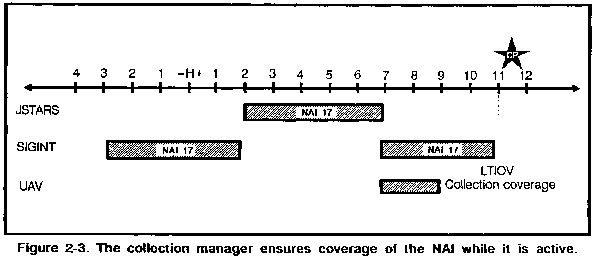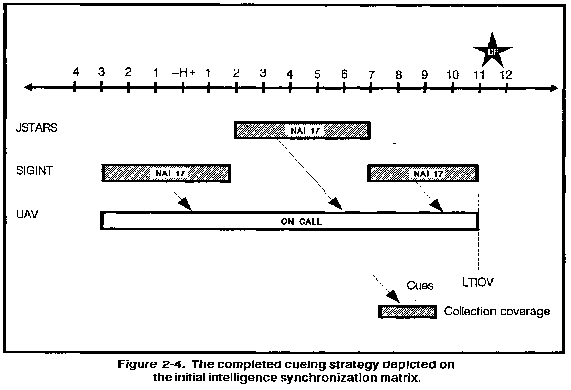
Table of
Contents
 Table of Contents |
The primary purpose of collection management
is to answer the commander's intelligence requirements while making
the best use of scarce intelligence collection resources. The
secondary purpose is to answer intelligence requirements of other
intelligence users.
Intelligence requirements generally focus on
intelligence required to prevent surprise, support planning, support
decisions during execution of' a friendly course of action (COA),
and engage high payoff targets (HPTs) in support of that COA.
They are products of the decision making and targeting processes.
Collection management satisfies these requirements by synchronizing
the activities of intelligence collectors and processors with
the command's operations.
Collection Management and
the Decision Making Process
The decision making process leads to the selection
of a friendly COA. The selected COA includes a list of' intelligence
requirements, some of which the commander will designate as PIR.
Each intelligence requirement supports a decision expected
to occur during execution of the selected COA.
Mission Analysis
In this step, intelligence preparation of the
battlefield (IPB) products enable the commander to assess facts
about the battlefield and make assumptions about how friendly
and threat forces will interact on the battlefield.
Mission analysis, supported by IPB, identities
gaps in the command's knowledge of threat forces, the battlefield
environment, and its effects on potential COAs. Based on the commander's
guidance, some of these gaps become the collection manager's initial
priorities for intelligence collection.
During mission analysis, the IPB process generates
a set of threat COA models. which include situation templates.
The significant differences between these COAs are the basis of
the initial event template and its supporting matrix. The collection
manager uses this initial event template and matrix to focus collection
on identifying the COA the threat will adopt.
Develop Courses of Action
In this step the staff develops friendly COAs
based on the facts and assumptions identified during mission analysis.
Among other things, they ensure that the potential friendly COAs
they develop have realistic expectations of the intelligence system.
Analyze and Compare COAs
During wargaming the staff "fights"
the set of threat COAs against each potential friendly COA. This
enables them to assess when and where they might require intelligence
about possible enemy activities or other events at key areas within
the area of interest (AI). These areas are NAIs.
Activity at NAIs helps to confirm or deny a particular
enemy COA relevant to the friendly COA. When, as a result of wargaming,
the commander discovers he must make a decision based on intelligence
from an NAI, that NAI becomes a decision point (DP) or creates
a DP related to that NAI. The information required to make the
decision becomes an intelligence requirement.
The staff uses several tools to record the results
of wargaming:
During this process the collection manager advises
the staff on the ability of the intelligence system to provide
the intelligence required to support anticipated decisions. Participating
in this process helps the collection manager better understand
the concept of the friendly operation and the intelligence required
to support it.
The collection manager uses the tools developed
during wargaming to develop and evaluate rough outlines of collection
strategies against each identified intelligence requirement; ensuring
that intelligence collection is capable of supporting the friendly
COA. He develops and depicts these strategies for each potential
friendly COA using his own synchronization tools--the intelligence
synchronization matrix (ISM) and collection plan.
Decision
Following staff recommendations, the commander
decides upon a COA and issues implementing orders. He also approves
the list of intelligence requirements associated with that COA,
developed before and during wargaming, and identifies the most
important as PIR.
During this step of the decision making process,
the collection manager normally briefs the intelligence collection
strategies that support each intelligence requirement. Once the
commander selects and approves a COA, he also approves the collection
manager's collection plan. The collection manager then implements
his plan by tasking and requesting collection.
Execution
As the command executes the selected COA, the
collection manager monitors execution of the collection plan.
He uses the ISM to ensure that--
During execution the collection manager keeps
abreast of both current operations and the intelligence situation.
He maintains continuous coordination with asset managers to ensure
effective cross-cueing and retasking of collection assets. This
allows him to take advantage of presented opportunities, to prevent
surprise, and to keep intelligence operations synchronized with
the command's operation.
For a complete discussion of the decision making
process, see FM 101-5. For a complete
discussion of IPB, see FM 34-130.
Collection Management and
the Targeting Process
The targeting process results in targeting guidance
that supports the command's COA. This guidance generates additional
intelligence requirements in support of each potential friendly
COA the targeting process supports.
Decide
As part of COA analysis and comparison, or immediately
after, the staff generally starts the targeting process with a
targeting conference. Using the results of staff wargaming and
IPB as a guide, they decide--
During the conference the collection manager
advises the targeting team on the ability of available collection
systems to acquire, identify, track, and assess BDA on HPTs. As
needed, he assists them in developing an architecture that relays
target intelligence to the attack systems in near-real time (NRT).
The targeting team further refines the event
templates and matrices to include the information the collection
manager will need to focus intelligence in support of targeting.
He uses these products, as well as the target selection standards,
to further develop and refine SIRs that directly support the targeting
process.
Detect
During this step the collection manager develops
collection strategies that will satisfy SIR which support the
targeting process. He plans for synchronized collection, focusing
on the proper HPT at each phase in the command's COA. If BDA is
required to support the command's COA, the collection manager
plans collection to satisfy that set of SIRs as well. When possible,
he plans and arranges direct dissemination of targeting intelligence
from the collector to the targeting cell or appropriate fire support
element (FSE).
During conduct of the COA, the collection manager
monitors execution of the collection plan. He uses the ISM (see
Chapter 3) to ensure that collection
assets are focused on the proper HPT (and their associated NAI
and TAI) at each stage of the operation. As targets of opportunity
present themselves, he tips off the appropriate FSE and cross-cues
collection assets to support the targeting effort, arranging BDA
as needed.
Deliver
During delivery, the collection manager cues
NRT collectors and reporters to continue tracking targets during
their engagement. Preplanned or cued BDA collection and reporting
help determine if the engagement produced the desired effects;
if not, continued tracking supports immediate re-engagement.
For a complete discussion of the targeting process,
see FM 6-20-10.
Collection Management and
Intelligence Synchronization
Intelligence synchronization is the process that
ensures the intelligence system provides answers to intelligence
requirements in time to influence the decisions they support.
Synchronization begins with the decision making
and targeting processes. Taken together, these processes identify
the decisions that must be made during execution of a COA and
its branches and sequels. It is these decisions which drive the
command's intelligence requirements. Every identified decision
should be supported by an intelligence requirement.
Other commands (higher, subordinate, and adjacent)
develop their intelligence requirements through the same processes.
They communicate their requirements to the collection manager
in the form of specific orders (from higher commands) or specific
requests (from subordinate or adjacent commands). The collection
manager integrates their requirements into his planning to satisfy
his own command's requirements.
To facilitate coordination, the collection manager
establishes intelligence handover lines between higher and subordinate
units. Requirements for intelligence in a given area can then
easily be directed to the unit with responsibility for that area
of the battlefield. Intelligence handover lines are especially
useful when tracking particular threat units or HPTs. "Handing
over" responsibility for the target as it crosses the coordination
line, accompanied by liaison, ensures that it is not lost in the
transition.
Synchronization continues during the collection
management process. The collection manager uses the products of
IPB, the decision making process, and the targeting process to
develop SOR sets that synchronize the activities of collectors
with the command's DPs. He ensures--
During execution the collection manager follows
up and monitors the collection effort reporting to ensure synchronization.
As needed, he prompts asset managers to meet timelines, cross-cueing,
and retasking as necessary to keep intelligence operations synchronized
with the command's operations.
An Example
While wargaming potential COAs, the division
commander states: "If the enemy commits more than one regiment
to secondary avenue of approach (AA) CAROL before the 1st Brigade
completes its counterattack, I will want to divert the attack
helicopters from the counterattack to reinforce the defense there."
The collection manager coordinates with the G2
and G3 plans officers and learns that 1st Brigade's counterattack
should be completed by H + 12 (with H-hour defined as whatever
time the enemy begins his main attack). The collection manager
writes a draft intelligence requirement supporting the commander's
decision about diverting the attack helicopters to read: "Will
the enemy commit more than one regiment to AA CAROL before H +
12?"
Following the wargaming session, the collection
manager coordinates with the all-source production section (ASPS)
to further develop the intelligence requirement. They identify
several SIRs and identify the NAIs and times, relative to H-hour,
they should appear. One of these SIRs reads: "Are more than
24 artillery weapons located in NAI 17?"
This particular SIR is active only until H +
11, so the collection manager establishes an LTIOV of H + 11.
(H+ 11 because the ASPS determined that the enemy would have the
artillery in NAI 17 not later than (NLT) H + 11 to support the
commitment of maneuver forces in AA CAROL by H + 12.) Similarly,
based on current dispositions and the set of predicted enemy COAs,
the ASPS deduces that H-3 is the earliest time the enemy would
deploy the artillery in NAI 17 (see Figure 2-1).

The collection manager uses this information
to focus collection on NAI 17 during a specific time window: H-3
to H + 11. This ensures the best use of assets by making them
available for other missions during times outside this window.
After reviewing available collection systems,
he decides to use a cueing strategy to answer this SIR. He plans
to use Joint STARS coverage to monitor movement into NAI 17. If
any is detected, he plans to cue unmanned aerial vehicle (UAV)
coverage of the NAI to identify the specific numbers and types
of equipment moving into the NAI. During those periods Joint STARS
coverage is not available, he plans to use signals intelligence
(SIGINT) to identify any artillery-associated activity within
the NAI. Again, he will cue UAV coverage if any is detected.
Noting that Joint STARS coverage is available
from H+ 2 to H+ 7, the collection manager requests moving target
indicator coverage of NAI 17 during that complete period (see
Figure 2-2). He follows this with
an order to the division's GSM to monitor the mission results
and "...report the arrival of more than 24 vehicles in NAI
17...."
For SIGINT coverage of the periods from H-3 to
H +2, and again from H + 7 to H+ 11 (when Joint STARS coverage
is unavailable), the collection manager develops similar SORs
for his SIGINT collection agencies (see Figure 2-3).
These are tailored to their specific capabilities. For example:
"Report artillery associated communications within NAI 17
between H-3 and H +2.... Negative reports required NLT H+2:30..."


To ensure that the UAV will be able to respond
to cues expected from the other collectors, the collection manager
writes an "on order" tasking.
In this case, it reads: "Between H-3 and
H+11, be prepared to conduct reconnaissance of NAI 17. Report
the presence of artillery weapons or associated equipment; include
number and type of equipment. Negative reports required..."
He coordinates with the division's air space managers to ensure
that air space to conduct the mission will be available during
the entire period (see Figure 2-4).
The Collection Manager's
Role
As the link between the command's intelligence
requirements and the collectors that satisfy them, the collection
manager is the key to intelligence synchronization.
The collection manager checks to ensure that
all decisions identified during COA development are supported
one-for-one by intelligence requirements. This usually involves
coordination with the planning staff or ASPS. He then manages
the collection management process to ensure that--

Desired End Effect
During planning of the command's COAs, the G2
or S2 can trace every--
During execution of the command's COAs, the G2
or S2 ensures that the intelligence needed to support intelligence
requirements reaches decision makers in time to influence their
decisions.
So What?
Successful synchronization provides critical
intelligence on time and on target.
Failure to synchronize results in--
The remainder of this manual addresses the application of the collection management process to accomplish synchronization. The process itself is discussed in Chapter 3. Common tools am techniques collection managers use to synchronize intelligence are in Chapter 4.